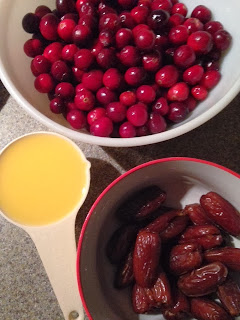I have been tweaking this pumpkin pie recipe for weeks and
it is finally perfect! My stipulations when creating the pie were no oil and no
sugar added, while still being easy to make. Needless to say, I have eaten lots
of healthy pumpkin pie over the last few weeks, so I am very excited to share
this version with friends and family!
Pumpkin Pie
Ingredients
Crust:
- 1 cup pecans
- 1 cup dates, pitted
- ½ cup oats
- ¼ cup flax
- ¼ cup water
Filling:
- 1 can pumpkin
- 1 cup dates, pitted (+1 cup water)
- 2 eggs
- ½ cup almond milk, unsweetened
- 2 tsp cinnamon
- ½ tsp nutmeg
- ½ tsp ginger
Preparation
Instructions
- Preheat oven to 400 degrees F.
- Soak dates for both crust and filling in boiling water for 10 minutes. (Make sure the dates for the filling are soaking in 1 cup of water).
- Drain dates for the crust and pulse in a food processor with remaining crust ingredients until thouroughly combined. Press into the bottom and up the sides of a pie pan.
- Add dates and soaking water for filling to food processor and blend until smooth. Whisk eggs and add to food processor with remaining filling ingredients. Blend until smooth.
- Pour filling into crust and bake for 35-40 minutes.
- Let cool for an hour at room temperature. Refrigerate for at least one hour before serving to allow pie to set up.
 |
| I boiled water in a tea kettle for soaking dates. |
 |
| Crust after mixing in food processor. |
 |
| Press crust into pie pan. |
 |
| Blend filling ingredients. |
 |
| Pour into crust. |
 |
| Bake at 400 degrees for 50 minutes. |
 |
| Let cool at room temp for an hour, then allow to set up in the fridge for at least one more hour. |
Fuel Facts
Numbers: 260 calories, 11 g protein, 12 g fat, 38 g carbs, 7
g fiber
**For 1/8
of the pie (1 big slice)
Ingredient Breakdown:
v
Oats –
Oats are known for their heart healthy benefits. They contain beta-glucan, a
specific fiber that helps lower cholesterol levels. Studies have shown, in
those with high cholesterol levels (over 220 mg/dl), ½ cup of oats or 1 bowl of
oatmeal can lower cholesterol by 8-23 percent.
v
Pecans –
The nuts contain healthy fats and phytochemicals that help lower cholesterol. Antioxidants
in pecans include ellagic acid, vitamin E, beta-carotene and lutein. They are
also a great source of protein & fiber.
v
Flax –
The tiny seeds are best to eat ground in order for the body to reap all of the
nutritional benefits. When the seeds pass through the body whole, they often
remain undigested. Make sure to store ground flax in the freezer because its
oils will otherwise go rancid rather quickly. It will keep for several months
when stored properly.
Flax is a good source of omega 3 fatty
acids in the form of ALA (alpha-Linoleic acid) which is a precursor for the
essential polyunsaturated fatty acids EPA and DHA. Omega 3’s are
anti-inflammatory and provide a host of health benefits when consumed in tandem
with omega 6 fatty acids. Aim for a omega 6 : omega 3 ratio closer to 1. The
standard American diet is much too high in the pro-inflammatory omega 6’s found
in safflower, corn and grapeseed oils. Consuming just 1 Tbsp of ground flax
each day can help improve your ratio.
v
Pumpkin –
My favorite fall vegetable is rich in carotenoids, some of which act as
precursors for vitamin A. This means that the antioxidants can be converted to
vitamin A in the body. Because vitamin A is a fat soluble vitamin, the
absorption of carotenoids increases when eaten with a healthy fat source. In
this case, almond meal.
Canned pumpkin is also an easy, low-calorie
way to bulk up your foods, keeping you satisfied longer. I especially enjoy
adding it to oatmeal and smoothies. Since pumpkin is not particularly sweet on
its own, you may want to include honey or maple syrup when using it in your
favorite recipes.
v
Dates –
One of nature's many gifts, dates are one of the best natural sweeteners. Not
only are they sweet, but they contain high amounts of fiber, promoting good
digestion & intestinal health.
v
Egg –
Eggs have the highest biological value of any protein source. This means that
you can achieve more of the benefits with less of the protein. Contrary to
popular belief, the dietary cholesterol in eggs is not associated with
increased blood cholesterol (the type of cholesterol that is linked to heart
disease). This misconception is continually being disproven with current
research.
In fact, the yolk is a nutritional power
house, containing high amounts of choline, a B-complex vitamin, and vitamin
B12. Choline has been linked with better brain function and is important in
preventing fat accumulation in the liver. Adequate B12 in the diet is crucial
for preventing anemia as well as neurological deterioration. B12 deficiencies
have been associated with Alzheimer’s disease in the elderly and neural tube
defects in newborns.
v
Almond
Milk – A creamy, low-calorie substitute for cow’s milk, this nutty variety
is easy to digest making it a good add to pre-workout meals or smoothies.
v
Cinnamon
– Many studies have shown the stabilizing effects of cinnamon on blood sugar.
This is beneficial for anyone who wants to keep energy levels constant
throughout the day, and especially helpful for diabetics or those who
experience hypoglycemia. Cinnamon has also been shown to act as an
anti-inflammatory by limiting the release of arachidonic acid from cell
membranes, a fatty acid that typically causes inflammation.



















